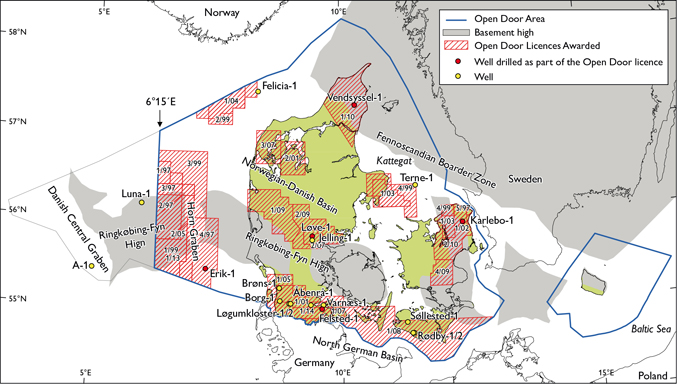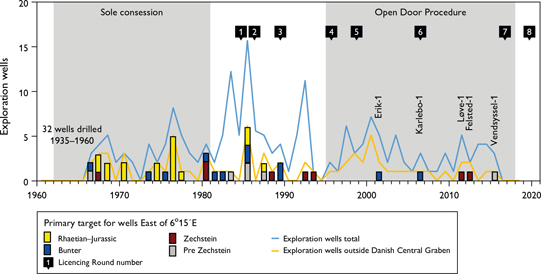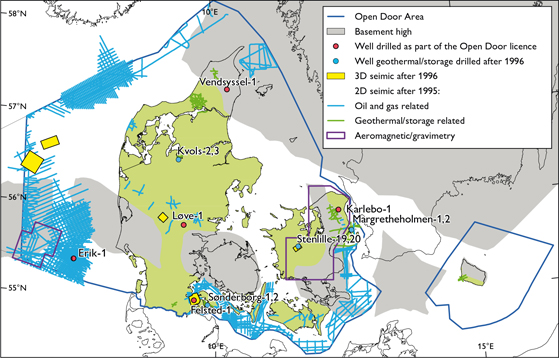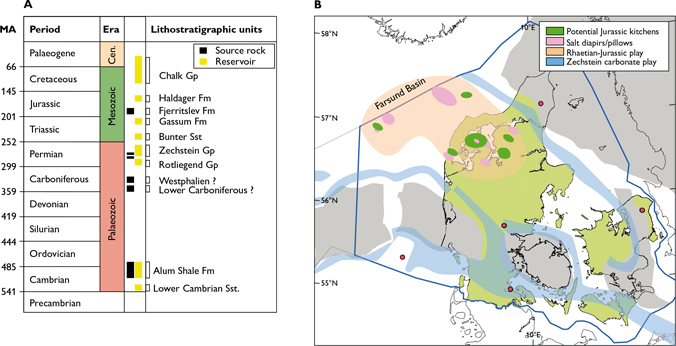REVIEW ARTICLE
Review of hydrocarbon potential in East Denmark following 30 years of exploration activities
Niels H. Schovsbo*1 and Finn Jakobsen1
*Corresponding author: Niels H. Schovsbo | E-mail: [email protected]
1Geological Survey of Denmark and Greenland (GEUS), Øster Voldgade 10, DK-1350, Copenhagen K, Denmark
GEUS Bulletin Vol 43 | e2019430105 | Published online: 17 June 2019
https://doi.org/10.34194/GEUSB-201943-01-05
Between 1993 and 2017, Denmark was one of the largest oil exporting countries in Europe having gained this position from its share in the highly prolific Danish Central Graben. However, outside the Central Graben few prospects have been adequately mapped, due to a lack of data in these so-called ‘white areas.’ As such, their potential for hydrocarbon accumulation remains uncertain. This paper presents an update of the prospect and play types in this area outside the Danish Central Graben, east of 6°15´E longitude (Fig. 1), based on results from the last 30 years of exploration activities. The paper is part of a resource assessment made by the Geological Survey of Denmark and Greenland (GEUS) to the Danish Energy Agency (Schovsbo & Jakobsen 2017) and is an update of a former review of the area made in 1987 (Thomsen et al. 1987). The succeeding exploration efforts have not changed the overall low expectation for the play types in the area. Here, we show that an uncertain resource is associated with both the Zechstein carbonate play in the North German Basin and the Upper Triassic – Lower Jurassic sandstone and lower Palaeozoic shale gas plays in northern Jylland. However, questions remain as to the source of hydrocarbons in the western offshore area. Specifically, we are unable to confirm (or refute) whether these structures are sourced via long-distance migration of hydrocarbons from the Danish Central Graben.

Fig. 1. Open Door licences awarded between 1996–2017 and wells mentioned in the text. For details, see Table 1.
Exploration history
With the 1995 amendments to the Danish Subsoil Act, an Open Door Procedure (ODP) was established for the area east of 6°15´E (hereafter termed the Open Door Area or ODA; Fig. 1) as a consequence of diminishing interest and lack of competition between oil companies in this part of the Danish sub surface. The flexibility of the ODP allowed licences to be awarded without holding an actual licensing round and especially sought to motivate small oil companies with innovative ideas to pursue oil and gas exploration. However, the Danish Government is currently preparing new legislation that will prohibit oil and gas exploration onshore and in inner Danish waters, thus terminating new oil and gas exploration activities within a substantial part of the ODA. The exploration activities resulting from the ODP in 1996 are briefly summarised in Table 1, Fig. 1 and below. For a full account of the activities prior to 1996, we refer to Thomsen et al. (1987) for the period up to 1983, and Danish Energy Agency (1995) for the period up to 1994. Following the implementation of the ODP in 1995 and until 2017, 27 licences were awarded resulting in the drilling of 5 wells (Erik-1, Karlebo-1, Felsted-1, Løve-1 and Vendsyssel-1) and the collection of various geochemical and airborne surveys as well as 6700 km 2D and 688 km2 3D seismic surveys. (Table 1; Figs 1, 2, 3). Except for the lower Palaeozoic shale gas play only the established plays have been tested and the introduction of the ODP has not led to increased drilling activity in eastern Denmark. On the contrary, activities began to stagnate in the 1970s when exploration focus shifted abruptly to the Danish Central Graben, following the success of the A-1 well.

Fig. 2. Drilling activities and concession rounds in Denmark 1960–2017. Based on Thomsen et al. (1987) for the period up to 1983. After the Open Door Procedure (ODP) was established the licencing rounds included only the area West of 6°15´E. Licences based on the eighth licence round have not yet been awarded (application deadline 1 February 2019).

Fig. 3. Seismic data, aeromagnetic/gravity survey and wells drilled after 1995.
Play types and concepts
Thomsen et al. (1987) identified the following plays to be relevant in the Danish area outside the Danish Central Graben, namely the Cambrian sandstone and Rotliegend sandstone, Zechstein carbonate, Bunter sandstone, Rhaetian (Triassic)–Jurassic sandstone, and Upper Cretaceous – Danian chalk plays (Fig. 4). In addition to these plays, unconventional shale gas and oil plays have since been identified and are included in this brief review. Here, the description is focused on data acquired from hydrocarbon exploration and/or from geothermal activities that have occurred since the Thomsen et al. (1987) review.

Fig. 4. A: Stratigraphical column with petroleum system elements for the Norwegian-Danish Basin. B: Zechstein and Rhaetian–Jurassic play map. Fm: Formation, Gp: group, Sst: Sandstone. For map legend, see Fig. 1. Based on Thomsen et al. (1987) and Petersen et al. (2008).
Cambrian Sandstone Play
Hydrocarbon production from Cambrian sandstones sourced from lower Palaeozoic shales occur in the Baltic Sea and onshore Poland and Lithuania. Similar sandstones occur throughout Denmark with potential source and seal provided by the Alum Shale Formation (Fig. 4A). In Denmark, expulsion and migration of hydrocarbons occurred during the Palaeozoic Caledonian Orogeny. Thermal modelling based on results from the Terne-1 well (drilled in 1985) in Kattegat and from the Vendsyssel-1 well (drilled in 2015) has, however, highlighted the significant risks related to reservoir quality and retention of hydrocarbons for this play in Denmark. This implies that it is highly unlikely that the Cambrian sandstones hold significant hydrocarbon resources, as previously stated by Thomsen et al. (1987).
Lower Palaeozoic Shale Gas Play
Thermogenic gas trapped in deeply buried Palaeozoic shales represents a new play, explored as part of three licenses (4/09, 1/10, and 2/10; Table 1) and in similar shales in Sweden and Poland (Schovsbo & Nielsen 2017). Although studies carried out by the U.S. Geological Survey (Gautier et al. 2014) and by European geological surveys (Zijp et al. 2017) indicate a considerable resource potential in Denmark, exploration of this play is still limited, and representative well data and production test data for the shales in Denmark are lacking. The Vendsyssel-1 exploration well revealed gas in the Alum Shale Formation, however, no test production was carried out, so the commercial potential is still unknown. The well was drilled within a so-called ‘sweet spot’, defined as an area with expected highest gas content (Schovsbo et al. 2014). Results from this well revealed the Alum Shale to be 40 m thick, compared to 180 m in Terne-1. It also contained much less gas than similar prospective parts of Poland, which leads to less favourable expectations for future activities, overall.
Rotliegend Sandstone Play
Permian aeolian sandstones form excellent reservoirs in the Netherlands, Germany and the UK, and similar facies are present in Denmark (Thomsen et al. 1987). The play occurs along the northern and southern margins of the Ringkøbing–Fyn High as well as in the Horn Graben (Fig. 1). The Rotliegend play has only been tested by a few wells (e.g. Felicia-1, drilled in 1987; and Borg-1, drilled in 1988). All wells penetrating the Rotliegend are characterised by the lack of hydrocarbon shows, indicating that filling of the structures from Palaeozoic sources is not likely due to a lack of mature in situ source rocks or the absence of a migration route from other mature source rocks (Beha et al. 2008).
The possibility of long-distance migration of hydrocarbons from the Danish Central Graben into structures in the western part of ODA was tested in two licences (1/97 and 2/97). This work included geochemical surveys and reprocessing of existing seismic data. However, the results were inconclusive regarding the hypothesis of long-distance hydrocarbon migration.
Zechstein Carbonate Play
Zechstein carbonates sourced by organic-rich intra (Z-1 and Z-2) carbonate beds and/or the Kupferschiefer occur in northern Germany and Poland and have been extensively explored within the ODA. The presence of oil in the Løgumkloster wells, as well as hydrocarbon shows in the Brøns-1 and Åbenrå-1 wells, confirm the presence of a Zechstein play along the southern edge of the Ringkøbing–Fyn High.
Eight licences focusing on the Zechstein carbonates play south (1/01, 1/05, 1/07, 1/08 and 1/14) and north (2/07, 1/09 and 2/09) of the Ringkøbing–Fyn High have been awarded. The licensing work included collection of seismic data, geochemical analysis of samples, and drilling of the Felsted-1 and Løve-1 wells. Hydrocarbons were found in Zechstein carbonate in the Felsted-1 well, but the gas contained more than 90% N2. The results of the exploration work confirmed the presence of hydrocarbons in the Zechstein carbonates but have not proven the presence of prospects of an economical size. New information on the presence of source rocks has not been established. On the northern flank of the Ringkøbing–Fyn High the Jelling-1 well (drilled in 1992) penetrated only 3 m into Zechstein carbonates and no source rocks were identified. Also, the Løve-1 well (drilled in 2011) was dry with no indication of source rocks. The exploration in the northern part of the Ringkøbing–Fyn High has thus not provided any new or positive indications of good reservoir intervals nor the presence of source rocks.
Bunter Sandstone Play
Good to excellent quality Lower Triassic reservoirs are widespread in Denmark (Mathiesen et al. 2010; Kristensen et al. 2016). The presence of N2 gas in Bunter in the Tønder structure confirmed the possibility of a Triassic play in the area, but it is dependent on the presence of structural closures and migration from mature source rocks. Drilling on salt structures (Varnæs-1, Rødby-1, -2, and Søllested-1, drilled 1952– 1982) found no traces of hydrocarbons. Therefore, the Triassic play in the North German Basin is uncertain with the lack of source rocks being the biggest risk factor.
In the Horn Graben, two licences (4/97 and 1/99) with a Bunter sandstone play as the target have been awarded. One dry well was drilled (Erik-1, 2001), which confirmed the results from previous wells in the area and verified the good reservoir properties of this interval. A basin modelling and structural development study of the area (Beha et al. 2008) revealed the lack of mature source rocks as the biggest determining factor for the presence of hydrocarbons at this location.
Rhaetian–Jurassic Sandstone Play
Until 1987, the bulk of the drilling activity in the ODA was directed towards the Rhaetian–Jurassic sandstone reservoirs in the Norwegian–Danish Basin (Fig. 4B). Based on the available source rock analysis and maturity modelling it appears that only minor amounts of hydrocarbons may have been generated and expelled from Lower Jurassic shales in deep rim synclines around the salt diapirs (Petersen et al. 2008). The Rhaetian–Jurassic sandstone play was investigated in licences 2/99 and 1/04 (Fig. 1). As part of the work programme for license 1/04, a comprehensive 2D seismic survey was carried out along with source rock screening of existing wells. The evaluation report for these wells stated that there are no mature source rocks in the area. Mature Lower Jurassic source rocks (with respect to oil generation) were, however, present in the Farsund Basin located in the Norwegian sector (Fig. 4B). But none of the investigations associated with the licences suggested mature hydrocarbons in rim synclines around salt structures, nor did they verify filling of structures by migrating hydrocarbons from mature source rocks in the Norwegian sector.
Rhaetian–Jurassic sandstones charged from local Lower Jurassic kitchens – areas where source rocks have reached suitable temperature and pressure to generate hydrocarbons – located in deep rim synclines, were targets in licence 3/07 in western Jylland (Fig. 1). The work programme did not result in any drilling activities, since only a limited hydrocarbon generative potential – in terms of maturity and quality – of the source rock is expected to be present in the area.
Upper Cretaceous – Danian Chalk Play
The chalk play is highly prolific in the Danish Central Graben where it is the single most important reservoir. In this play the Maastrichtian–Danian chalks are sourced by Upper Jurassic to lowermost Cretaceous marine shales and sealed by Paleogene shales or intra-chalk tight zones. However, outside the Danish Central Graben area, maturity modelling indicates that these Jurassic shales may not have reached oil-maturity. Therefore, the play in the ODA has to rely on long-distance migration from the Danish Central Graben as tested by the two licences (1/97 and 2/97). However, the investigations did not yield a final conclusion on the existence of long-distance migration from the Danish Central Graben into the ODA.
Conclusions
The Danish area east of 6°15´E contains several plays including the lower Palaeozoic unconventional gas, Zechstein carbonate in the North German basin and the Rhaetian (Triassic) – Lower Jurassic sandstone in northern Jylland. However, exploration activities have not been able to demonstrate the existence of commercial quantities of hydrocarbons. For the Zechstein carbonate play, all identified structures appear to be of limited size, the reservoir quality is generally poor, and the presence of source rocks is uncertain. The Rhaetian–Jurassic sandstone plays depend on local kitchens developed around salt diapirs. Current data suggest that kitchen areas are limited in extent. The Palaeozoic shales appear to be thinner than expected and to include less gas than similar prospective shales in Poland.
Exploration activities during the past 30 years (including the ODP) confirm the presence of the previously identified uncertain plays in the ODA. The ODP has not identified new conventional plays and has not proved or disproved the major unknowns in the area, namely the presence of mature source rock. Instead, data gathered for these activities have highlighted the excellent reservoir properties of Rhaetic–Jurassic and Bunter sandstones as particularly appropriate geothermal reservoirs.
Acknowledgments
This is a part of an ongoing EU Horizon 2020 GeoERA project (The GARAH, H2020 grant #731166 lead by GEUS).
References
Beha, A., Thomsen, R.O. & Littke, R. 2008: Thermal history, hydrocarbon generation and migration in the Horn Graben in the Danish North Sea: a 2D basin modelling study. International Journal of Earth Sciences 97, 1087–1100. https://doi.org/10.1007/s00531-007-0247-2
Danish Energy Agency 1995: Rapport om Efterforskningspotentialet i Øst-Danmark (Including English summaries). Arbejdsgruppen vedr. vurdering af det østdanske efterforskningspotentiale, 50 p. Unpublished report, Danish Energy Agency, Geological Survey of Denmark and Greenland & DOPAS (in archives of Geological Survey of Denmark and Greenland, GEUS Report File no. 13086).
Gautier, D.L., Schovsbo, N.H. & Nielsen, A.T. 2014: Resource potential of the Alum Shale in Denmark. Proceedings of the 2nd Unconventional Resources Technology Conference. Denver, Colorado, USA, 25–27 August, 2014. https://dx.doi.org/10.15530/urtec-2014-1931754
Kristensen, L., Hjuler, M.L., Frykman, P., Olivarius, M., Weibel, R., Nielsen, L.H. & Mathiesen, A. 2016: Pre-drilling assessments of average porosity and permeability in the geothermal reservoirs of the Danish area. Geothermal Energy 4, 27 pp. https://doi.org/10.1186/s40517016-0048-6
Mathiesen, A., Nielsen, L.H. & Bidstrup, T. 2010: Identifying potential geothermal reservoirs in Denmark. Geological Survey of Denmark and Greenland Bulletin 20, 19–22.
Petersen, H.I., Nielsen, L.H., Bojesen-Koefoed, A., Mathiesen, A., Kristensen, L. & Dalhoff, F. 2008: Evaluation of the quality, thermal maturity and distribution of potential source rocks in the Danish part of the Norwegian–Danish Basin. Geological Survey of Denmark and Greenland Bulletin 16, 66 pp.
Schovsbo, N.H. & Jakobsen, F. 2017: Kulbrinteefterforskningspotentialet i Åbendørområdet samt betydningen af hydraulisk frakturering for udnyttelsen af kulbrinteressourcer og af geotermi-ressourcer, 18 pp. Unpublished Report (in archives of Geological Survey of Denmark and Greenland, GEUS Report File no.34280).
Schovsbo, N.H. & Nielsen, A.T. 2017: Generation and origin of natural gas in lower Palaeozoic shales from southern Sweden. Geological Survey of Denmark and Greenland Bulletin 38, 37–40.
Schovsbo, N.H., Nielsen, A.T. & Gautier, D.L. 2014: The Lower Palaeozoic shale gas play in Denmark. Geological Survey of Denmark and Greenland Bulletin 31, 19–22.
Thomsen, E., Damtoft, K. & Andersen, C. 1987: Hydrocarbon plays in Denmark outside the Central Trough. In: Brooks, J. & Glennie, K.W. (eds): Petroleum Geology of North West Europe: Proceedings of the 3rd Conference on Petroleum Geology of North West Europe, Barbican Centre, London, 26–29 October, 1986. Geological Society of London, UK.
Zijp, M., Nelskamp, S., Schovsbo, N.H., Tougaard, L. & Bocin-Dumitriu, A. 2017: Resource estimation of eighty-two European shale formations. Proceedings of the 5th Unconventional Resources Technology Conference, Austin, Texas, USA, 24–26 July, 2017. https://doi.org/10.15530/urtec-2017-2686270
How to cite
Schovsbo, N.H., Jakobsen, F. 2019: Review of hydrocarbon potential in East Denmark following 30 years of exploration. Geological Survey of Denmark and Greenland Bulletin 43, e2019430105. https://doi.org/10.34194/GEUSB-201943-01-05